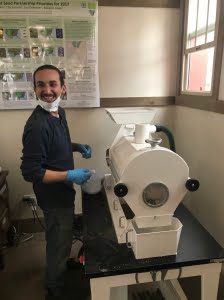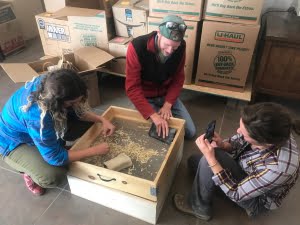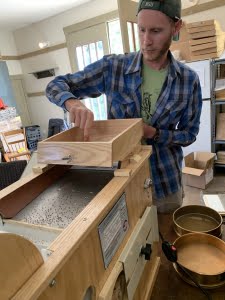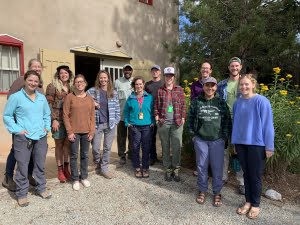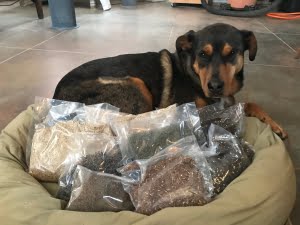
Oh, the places seed goes…
By Laynie Saidnawey and Maria Mullins
February 2020
By the time seed arrives at the IAE Southwest Office Seed Studio in Santa Fe, New Mexico, to be processed and cleaned, some collections have traveled close to 300 miles from their source populations. However, this move is temporary; the seed will eventually make its way back to the region where it is genetically adapted to survive. After all, what better role could it play than in the ecosystem where it evolved with the soil, climate, pollinators, and herbivores of the area?
The Seed Studio is a central hub for wild collections of native grass, shrub and wildflower seed collected across New Mexico and Arizona for the Southwest Seed Partnership. During the 2019 field season, IAE SW partnered with the Bureau of Land Management, US Forest Service, National Park Service and the NM Department of Transportation to coordinate 6 seed crews collecting across 7 ecoregions in NM and AZ. After weeks and weeks of scouting for healthy populations and collecting mature seed in the hot sun, all of the crew’s work culminates here at the Seed Studio, where their collections wait patiently in a temperature-controlled environment to be processed and cleaned.
How do we clean seed? Collected seed often arrives in a bag with other plant parts (stem segments, bracts, fluff, etc.) that need to be separated from the seed. Seed cleaning involves two steps: a coarse clean, which physically breaks or pulls off other plant parts from the seed, and then a fine clean, which separates the seed from this debris, unfertilized seed, and foreign seed. We clean seed using three pieces of mechanized equipment, starting with the Westrup Brush Machine (coarse clean). This machine uses rotating brushes against different size mantels (round metal sieves with various size holes in them), to break apart seeds from pods, husks, or other plant material. The fine clean can happen in two ways: (1) using a continuous air separator, a machine that utilizes airflow and gravity to separate the usually heavier seed from lighter dried plant materials, or (2) a Clipper Office Tester, which uses a set of two screens and airflow to separate material based on size and weight. Finally, we have a variety of hand tools such as sieves and screens that result in beautiful clean seed with unique shapes, sizes and colors.
Where does the seed go? Most seed leaving the seed studio will go directly to southwest farmers who plant production fields with the goal of increasing the quantity of healthy, genetically diverse seed available for large-scale projects such as post-fire restoration and oil-and-gas reclamation. Other collections will be delivered to southwest biologists, who excitedly wait for the opportunity to complete their own restoration or research projects. For example, this year we delivered cleaned seed to a researcher at New Mexico State University investigating novel and effective seeding methods in the Chihuahuan desert and a researcher at the NM Institute for Mining and Technology who is testing different germination methods on several of our priority species. Some seed goes to horticultural training programs such as for the NM Nature in Prisons project in Santa Fe, and the Sandia High School nursery project in Albuquerque, New Mexico. Seed not used immediately is placed in cold storage.
Why do we clean seed? Cleaning seed is not only important for maintaining viability in long-term storage and reducing the potential for disease, seed predators, and weed seed contaminants, but it is also necessary for understanding the quality of a seed lot. Once seed is cleaned it is sent to a seed-testing lab. Seed testing provides a report of weed content and also Pure Live Seed (PLS = % total germination x % purity/100) for each seed lot. The higher the PLS, the more viable seed you have in that lot, and the lower the quantity of chaff and nonviable seed. Restoration practitioners and seed producers can use seed tests to assess the overall seed quality and value for the price. They also use PLS to more accurately calculate seeding rates for production fields and large-scale restoration projects.
Our Multi-use Seed Studio In addition to being a seed cleaning facility, the Seed Studio serves as an educational space. We host seed cleaning workshops to expand the knowledge about native seeds to the community. The Seed Studio also houses our herbarium (pressed plant library), containing carefully documented plant specimens from all of our Southwest Seed Partnership seed collection sites. These specimens serve as “vouchers” that verify plant identity and source location for seed certification, can be used in research, and serve as teaching collections for new seed collection crews to learn the species they will encounter.
Something to be proud of: Since the time seed started arriving to the Seed Studio in September this year, our hard work has resulted in 76 pounds of cleaned seed from 201 collections of 63 different species.
Seed send-off…
"You're off to Great Places!
Today is your day!
Your mountain [restoration site] is waiting,
So... get on your way!”
-Dr. Seuss
We are grateful for seed crew members, staff and volunteers who have helped collect and clean seed, and thank our Southwest Seed Partnership funders, including the NM Bureau of Land Management, Forest Service Region 3, National Park Service, Native Plant Society of NM, and NM Department of Transportation. Finally, we have been able to accomplish so much thanks to this Seed Studio space made available by the Quivira Coalition this year.
Restoration
Research
Education
Get Involved
Contact
Main Office:
4950 SW Hout Street
Corvallis, OR 97333-9598
541-753-3099
[email protected]
Southwest Office:
1202 Parkway Dr. Suite B
Santa Fe, NM 87507
(505) 490-4910
[email protected]
© 2024 Institute for Applied Ecology | Privacy Policy


